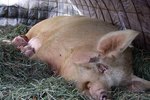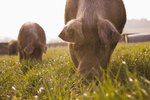
Hydration is a challenge for livestock farmers, as all animals, from the smallest rabbit to the largest buffalo, require clean water to survive and stay healthy. Hogs, with strong snouts and an unstoppable urge to root, present particular problems, often knocking over waterers to create mud holes for wallowing. Expensive waterers are available for purchase, but many pig farmers choose to build DIY PVC waterers for a fraction of the cost.
Water Hogs

While animals need a handful of basic provisions to survive, including food and shelter, none is more important than water. While animals can survive with drastically reduced food sources, even a slight loss of water can result in death, as hydration enables and sustains necessary biological functions. Finishing pigs can consume as much as five gallons of water a day, and a lactating sow may need even more than that. Providing necessary hydration can be costly, and pools of dumped water are frustrating sights for the budget-conscious hog keeper.
What's with the Spills?

Before buying or building a hog waterer, the pig farmer must ask one important question: “Can my pigs knock this over?” While buckets or a lightweight trough may seem like economical hydration solutions, a pig's urge to wallow will quickly tax his keeper's wallet and patience when he uses his snout to empty the contents onto the ground. Though he may appear malicious, a pool-creating pig, in creating a wallowing hole, is creating a porcine “service station” for temperature regulation, sun protection and parasite control. However, this explanation doesn't warrant a cavalier attitude to water waste.
Make Your Own

DIY hog waterers made from PVC pipes are low-tech hydration solutions that are portable for moveable pig pastures and require very little building experience. Large, heavy-grade PVC pipe, 8 inches diameter cut to desired length, is a good starting point, though size is the builder's choice. The pipe is cleaned, and a cap is secured to the bottom end using an adhesive, such as PVC cement. A correctly-sized hole is cut toward the capped bottom, into which a nipple valve (see below) is threaded and secured using cement and plumber's putty. The finished waterer can be attached to a post with wire or straps, and removed at will.
About Those Waterer Nipples
A hog waterer nipple is the one supply for this project that can't be purchased at the local hardware chain, but one (or more) is easily obtainable at farm supply stores or from online retailers. The nipples are inexpensive (generally $5 or less), stainless-steel valves, usually ½ inch in diameter, that a pig bites to release water into his mouth; when the animal releases his bite, the flow ceases and water is conserved. These nipples are so effective, however, that pigs won't have any spillage to create important wallowing holes, so it's up to the keeper to provide a spot for a quick mud bath.
References
Photo Credits
-
Thomas Northcut/Digital Vision/Getty Images
Writer Bio
Rodney Wilson is owner and manager of Goldfinch Farm in central Kentucky, where he oversees veterinary and management practices for a diverse group of animals, from dogs and cats to pigs and chickens. He's written professionally since 2001, with articles appearing in such publications as The Cincinnati Enquirer, CiN Weekly, Baby Guide and Akron Life.




